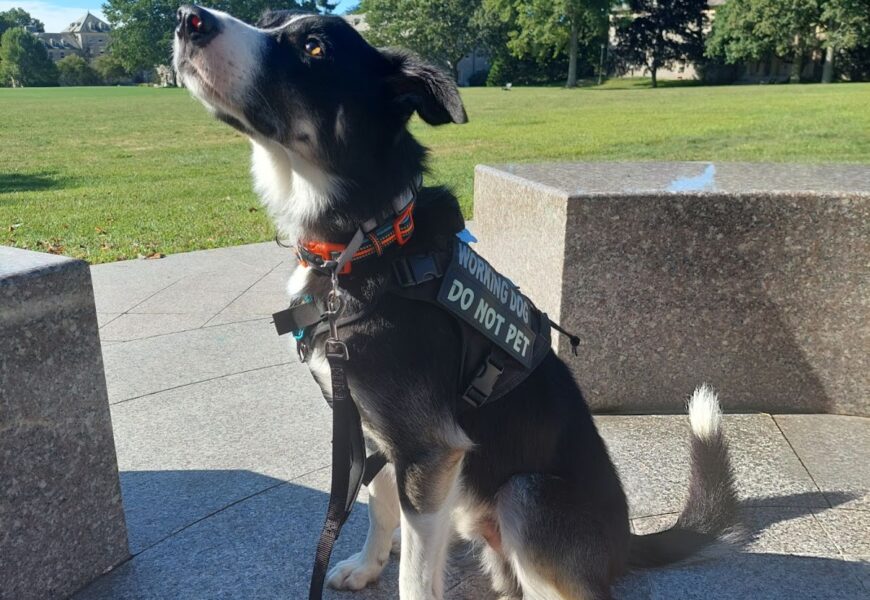They’re loud. They’re dirty. They move in flocks. And every fall, to the dismay of everyone on campus, they take over the school. From the waterfront to Tempel Green, they’re everywhere. Anywhere you look, everywhere you smell, there’s a pack of them hanging out. No, not first-years – geese. And this year, someone is doing something about it. He’s two years old, has black and white fur, and a tongue that lolls outside his mouth. He’s Beau – a professionally trained border collie that, along with owner Emily Tansey, spends his days running after geese on fields, golf courses, private properties, and at Connecticut College.
Emily and Beau are the team that make up Wingman Goose Control, a company the college has hired to spend the next several months chasing the goose population off campus. Believe it or not, goose control wasn’t Emily’s dream job as a child – and it wasn’t her first career, either. For eight years, she worked as a police officer in Groton, but had other aspirations: “I knew I wanted to work with a dog. That was kind of my life goal,” Emily said. After trying to become a canine officer, a highly sought-after position, she moved on, first to private security, and then to police dispatch. “I just kept looking for something where I’d be able to work with a dog on a regular basis, and I liked the idea of being my own boss,” she said. Eventually, she came across somebody that had started a goose control operation with their own dog at an airport, and inspiration struck. Wingman Goose Control was born.
Similarly, Beau did not start out working with geese. Born and raised in Montana, he spent his first days learning to herd sheep. After attending a goose control training program for border collies, he ditched livestock for water fowl, and hasn’t looked back since. Of course, Beau doesn’t just chase geese without rhyme or reason. Because they’re so stubborn, Emily and Beau can’t run them off once or twice and expect them to disappear. Unless something truly scares them away, geese return to the place they were hatched every year for their entire life, which can be up to 20 years in the wild. That’s why Emily said their work is “systematic and randomized harassment of the geese, so they learn that they can’t know when to expect when there’s going to be a predator on the property, and then they don’t feel safe coming back.” Usually, they visit campus two times a day, five days a week – anything less won’t do much to displace Conn’s resident geese.
The goal of their work is exactly that: to displace them. Throughout the process, Emily and Beau make sure that the campus geese remain unharmed. Emily explains that border collies like Beau are typically used for goose control because they’re a very gentle breed. “Even when they’re working sheep, they don’t really want to bite the animals; they just want to go out, come around them, and intimidate them towards the shepherd. So really, what he’s doing when he goes after the geese is trying to bring them back to me – but because they can fly, obviously they take off,” she said. And because Canada geese are federally protected, if Beau did end up harming a bird, Emily would have a big problem: “If he grabs a bird and hurts it, I could be liable to lose my license, I could be fined. So you have to be very careful, and you have to go through a Nuisance Wildlife Control Operator course with the state of Connecticut.”
So if Beau is so gentle, why does he have the words “Do not pet” emblazoned on either side of his vest? The answer is pretty simple, actually – Emily says it’s mostly for liability insurance. Nevertheless, although Beau is friendly, she says the lack of attention might be for the best: “Like any working dog, it’s probably better that he isn’t being pet all the time, ‘cause then he’ll come here and think that that’s what we’re doing instead of trying to chase geese!”
Not only is a dog a more humane method than some of the other goose control options out there, from pellet guns to poisonous lawn applications that upset birds’ digestive systems, but it’s also a more effective method. There are plenty of technological solutions, and Emily uses many of them alongside Beau: green lasers, RC boats, air horns, and floating alligator heads are all at her disposal. However, while they can be helpful, none of them are nearly as effective as a dog. “The other day, I got a call out and I was told that the geese were down at the lower property. I didn’t have [Beau] with me; I was just out doing errands and I was like ‘I’m gonna try and go there and get them to leave anyways.’” Despite her tools and know-how, Emily explained that she just couldn’t get them to budge: “The laser didn’t work, and I went right up to them with an air horn and they still didn’t care. And he could have cleared them off the property in like fifteen seconds – he would’ve just run right at them and they would have taken off.'”
If you haven’t had a chance to spot him yet, don’t worry: Beau isn’t leaving campus anytime soon. Emily says that there are two types of goose flocks – resident geese and migratory geese, known as “pond hoppers.” While it takes around a month of harassment to get the resident geese to realize that campus is no longer safe, the migratory birds, who see a nice property from the sky and may decide to eat or even stick around for a week or two, don’t yet know that Beau is here. For them, Emily and Beau will be returning for months to come.









